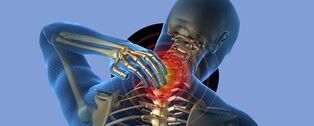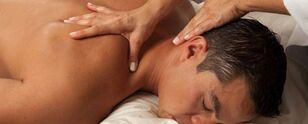A common disease is osteochondrosis of the cervical spine, which occurs in people of any age, and especially among the working population aged 30 to 50 years. Some people suffer from this disease, sometimes not knowing the cause of the ailments, because degenerative changes in the cervical spine occur in an imperceptible way. Timely treatment of cervical osteochondrosis will return a person to excellent health and give him health in the future.
Symptoms and signs of cervical osteochondrosis
Cervical osteochondrosis early in the disease may not appear at all. The disease already makes itself felt in a careless way with frequent headaches and neck when moving. When there is a violation of cerebral circulation in cervical osteochondrosis, a person develops the following symptoms:
- regular headaches;
- violation of the sensitivity of the facial muscles;
- increased fatigue;
- head noise;
- ringing in the ears;
- high blood pressure;
- loss of coordination;
- frequent dizziness;
- trembling march.

If osteochondrosis of the cervical vertebrae takes a chronic form, the pain is permanent and movements of the head are difficult due to the tension of the neck muscles. The patient begins to suffer from cervical migraines, and the headache is sometimes accompanied by vomiting, nausea, and even loss of consciousness. If cervical osteochondrosis is not treated in time, the person may be accompanied by pharyngeal symptoms: difficulty swallowing, a dry throat sensation, itching and tingling. Over time, this disease can lead to a herniated disc.
Methods for the treatment of osteochondrosis of the cervical spine
The treatment of osteochondrosis of the cervical spine includes a wide range of tools and methods that aim to eliminate pain and combat the inflammatory process in the tissues. One effective method is daily exercise for spinal flexibility. As a general rule, a doctor selects an individual exercise program after diagnosis by MRI or CT scan and evaluation of the stage of the disease. Let's see how osteochondrosis of the cervical spine is treated.
Medications: pills, medications and injections
Drug therapy is already prescribed at the first signs of cervical osteochondrosis. If the first pain can be removed with a regular anesthetic pill, then it will no longer help. The medical treatment of cervical osteochondrosis is carried out with new generation chondroprotectors - drugs that stimulate the restoration of cartilage tissue in the spine. The best therapeutic effect is provided by a combination of glucosamine and chondroitin sulfate. The course of treatment with these drugs can be several months of admission, after which the mobility of the cervical spine improves.

But if you need to relieve acute pain in cervical osteochondrosis, doctors prescribe a novocaine blockade or non-steroidal anti-inflammatory drugs. These are ointments, capsules, tablets and injections that rapidly improve the general condition of the patient. But if chondroprotectors have no contraindications even with prolonged use, NSAIDs have serious ones, so their use should be agreed with the attending physician.
Local remedies: gels and ointments
To quickly anesthetize the cervical spine in case of osteochondrosis, special gels or ointments will help, which begin to act 10 minutes after application. There are several types of them:
- Regenerative, allowing the restoration of damaged cartilage tissue between the vertebrae.
- Anti-inflammatory, based on non-steroidal substances, eliminating pain.
- Analgesics that affect nerve endings, which quickly relieve pain.
- Massage ointments.
Manual therapy
The oldest method, but no less effective than modern methods of treating osteochondrosis, is manual therapy. Specialists have developed many techniques that have a beneficial effect on the vertebrae, tissues and joints in the affected area. Only a chiropractor should be a good specialist in her field, so as not to put the patient in a wheelchair. The main methods of manual therapy for osteochondrosis of the cervical spine are:
- segmental massage that relieves muscle tension;
- recovery manipulation joint performance, accompanied by its crunch;
- mobilization, restoring damaged joints by stretching them.

Acupuncture
With the help of acupuncture, you can not only eliminate pain symptoms in cervical spine osteochondrosis, but also completely cure it. The needle technique came to Russian medicine from the East. Chinese sages, guided by the philosophy and knowledge of the human body, have learned to regulate the body's energy by means of metal needles. The acupuncture procedure is recognized today by doctors as an extremely effective method to combat osteochondrosis.
But before resorting to acupuncture, you should consult a doctor, as this procedure is not suitable for everyone. You cannot use this technique:
- in the presence of infectious diseases;
- pregnancy;
- any tumor;
- skin or blood diseases;
- old age or childhood.
Homeopathic remedies
Cervical osteochondrosis is successfully treated with homeopathy. Homeopathic preparations contain useful trace elements and biologically active substances. They fully correspond to the concentration of vitamins and minerals in the human body. Homeopathic preparations contain plant extracts, herbal extracts extracted from organic samples, and most importantly, they are completely natural. The principle of its action in osteochondrosis:
- Activates the immune system.
- Restores cartilage tissue.
- Improves blood circulation in the neck area.
How to cure cervical osteochondrosis at home
Complex treatment of cervical osteochondrosis at home is now possible. It is very possible to achieve better health and relieve pain symptoms on your own by following a correct diet and leading an active lifestyle. The daily diet for cervical osteochondrosis should contain foods that promote the regeneration of cartilage tissue, these include:
- legumes, cereals, vegetables, fruits;
- containing protein: nuts, eggs, lean poultry, fish;
- unsaturated fatty acids: flax seeds, blue sea fish;
- foods rich in calcium: milk, cottage cheese, leafy vegetables.
Massage and self-massage

Successful home treatments are done with massages or self-massage. This procedure relieves tension by relaxing tight neck muscles. After massage, it improves blood circulation in the intervertebral discs, which provides quick relief to the patient. The self-massage procedure is performed in a sitting position and is performed using rubbing, stroking, and kneading movements on the back of the head. But for greater effect, it is better to invite a qualified masseuse.
Wellness gymnastics
Recovery gymnastics has no less effect than drug treatment for osteochondrosis and is the basis for recovery. The exercises won't take long, especially since they are easy to do at home. Gymnastics is aimed at relieving pain in osteochondrosis of the cervical spine, stretching the ligaments and relaxing the neck muscles. But you need to do the exercises only after consulting a doctor and very carefully so as not to harm the body.
Traditional medicine recipes
When asked about how to cure osteochondrosis of the cervical spine at home, as a rule, it comes to folk remedies. Herbal treatment is inexpensive, effective, and most importantly, safe. You don't need to buy expensive pain relief medications, which can also have negative side effects. Natural remedies for traditional medicine that help with osteochondrosis of the cervical spine include:
- Horseradish leaves. You need to put the sheet on the back of your neck and fix it overnight. In the morning, the pain will be gone.
- Potatoes. It should be rubbed with honey in the same proportion so that the mixture resembles an ointment in consistency. Use the product as a compress at least once a week.
- Compresses made of vodka (1 l) with the addition of freshly squeezed aloe juice (1 tbsp. l. ), mustard powder (1 tbsp. l. ) and propolis (50 g) are effective. The mixture is impregnated with a cloth and applied to the neck, fixing with a woolen cloth, the procedure is carried out 1-2 times a week at night.

Disease prevention methods
It is easier to prevent osteochondrosis than to treat it for a long time. Prevention includes adherence to posture, physical exercises, exercise equipment, walking, yoga, swimming. It is necessary to sit correctly at the table and the computer, you can not throw your head back for a long time or bend over when lifting weights. When writing or reading, bending over the table surface is not recommended, and it is advisable to use an orthopedic pillow during sleep.



















































